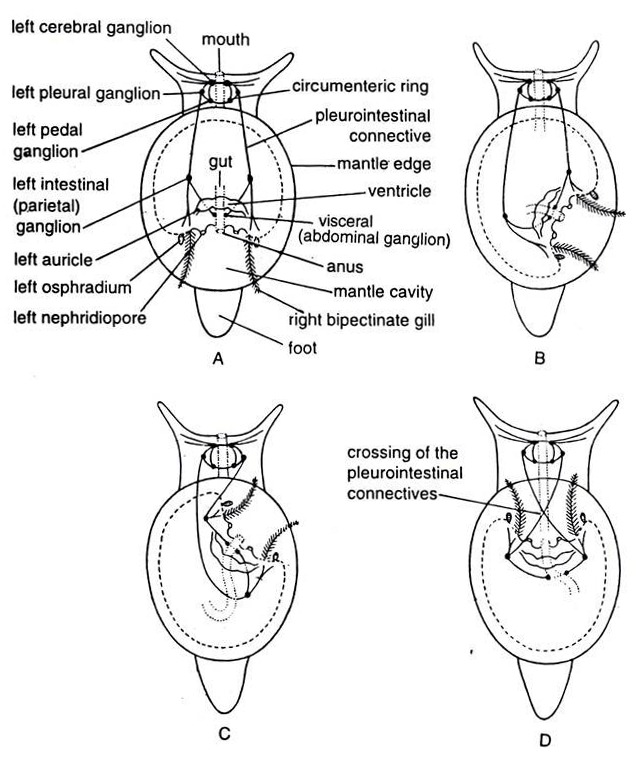In this article we will discuss about:- 1. Description of Torsion 2. Course of Torsion 3. Ways 4. Effect 5. Significance.
Description of Torsion:
180° anticlockwise twisting of the visceropallium on the head-foot long axis during early development in gastropod molluscs is torsion. It is an early and fundamental event in gastropod ontogeny (the event in phylogeny, which brought the gastropod in being). Most of the organs are affected by torsion and certain structures initially lodged posteriorly are brought to the front.
A narrow neck behind the head connects the head-foot and visceropallium, through which runs the oesophagus, rectum, anterior aorta, visceral loop and muscles attached to the shell. The short, narrow neck is the site of torsion (Fig. 26.33).
ADVERTISEMENTS:
Fig 26.33. Torsion in gastropod mulluscs.
A. Hypothetical untorted gastropod-type mollusc. B-C. Stages of torsion. D. Complete torted stage
Course of Torsion:
ADVERTISEMENTS:
The pre-torsional larva is bilaterally symmetrical; the mantle cavity is posterior and ventral; gut straight, opening posteriorly. A ventral flexure of the body changes the straight alimentary canal to a loop and the mouth and anus come close to each other. Initially saucer-shaped visceral mass and shell assume a cone shape and later become spirally coiled.
Ways of Torsion (Mechanism):
Torsion can be brought about in the following ways:
1. 180° rotation by muscle contraction alone. Example: Acmaea.
2. Rotation occurs in two stages — first 90° by contraction of larval retractor muscles and the second 90° by differential growth. Examples: Patella, Haliotes, etc.
ADVERTISEMENTS:
3. Rotation by differential growth alone. Example: Vivipara.
4. Rotation by differential growth, the anus coming to a position as in the adult.
Example: Aplysia.
Effect of Torsion:
1. Position of organs in pre-torsional stage:
Posteriorly located mantle cavity opens backward; mouth and anus at opposite ends; ctenidia pointed backwards; auricles behind the ventricle; nervous system bilaterally symmetrical; coiled visceral sac and shell dorsal or exo-gastric.
Position of organs in post-torsional stage:
Mouth cavity opens in front just behind the head; gut assumes U-shape; anus lies in front near mouth; ctenidia shifted to front, directed backwards, the right one shifted to the left and vice versa, the auricles become anterior to the ventricle and the position changed—right to left and vice versa; nervous system becomes twisted into a figure of ‘8’ by crossing of the pleurovisceral connectives; coil of visceral sac and shell become ventral or endogastric.
Asymmetry and Loss of Organs:
In specialised forms the visceral organs of one side, viz. the ctenidium, auricle and kidney fail to develop. These organs of the original right side become topographically placed on the left side.
Significance of Torsion:
ADVERTISEMENTS:
Author are in agreement that torsion is the result of a larval mutation but they do not agree on the advantage of such mutation restricted only to the larva or extends to the adult.
1. Due to torsion the mantle cavity becomes anterior and the sensitive parts of the anterior end including the head and also the foot of the larva could be withdrawn into the mantle cavity at the approach of danger. Garstang (1928) holds that torsion represents a larval mutation, which is of advantage to the larva and not the adult, a concept shared by Yonge (1947).
By rotation the anteriorly placed mantle cavity provides a refuge for the delicate head and velar lobes of the larva, and it is not directly advantageous to the adult.
2. Morton (1958) believes the final effects of torsion due to larval mutation are profound in the adult snails though in a different way:
a. Torsion promotes stability in the adult by bringing the body of the snail nearer to substratum.
b. The free flow of respiratory water current in the posteriorly located mantle cavity containing the gills is obstructed by the back- flow of water current during upstream movement of the snail. In reverse situation, anteriorly placed mantle cavity is continuously flushed with fresh water current.
c. The forward position of the receptors enables the snail to scan the surroundings and also test the quality of water and mud.
